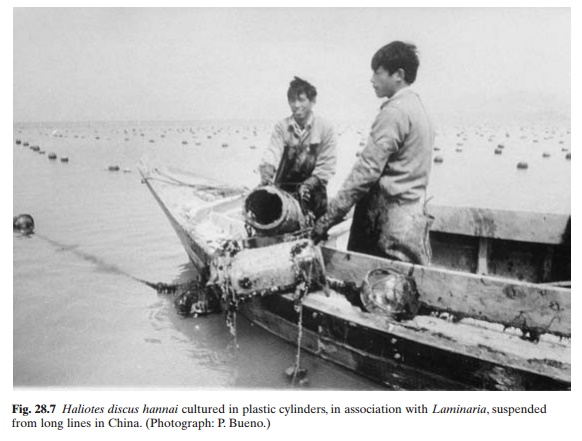Chapter: Aquaculture Principles and Practices: Clams, Scallops and Abalones
Grow-out of Abalones
Grow-out
Juvenile abalones of 5mm size are generally transferred to grow-out tanks, and are gradually introduced to macroalgae. For the juveniles of the Japanese species of abalone, particularly H.discus hannai, the most suitable food for growthare Undaria and Eisenia, followed by Codium,Ulva, Grateloupia and Rhodymenia. Benthicdiatoms are very suitable food until the juveniles reach a shell length of about 20mm.
Egregia and Macrocystis are commonly fed toabalones in the USA. When they reach a size of 15–20mm, a diet of macroalga is required. The stocking density in grow-out tanks with gravel substrates in Japan is about 2000–2500 per m2. The mortality of young abalones of 5mm size in commercial culture is very high (as high as 99 per cent), but it is much less (about 10 per cent) from the 5 to 30mm stage.
On the Californian coast in the USA, abalone growers concentrate on growing to the speciality market size of 5–10cm, rather than the normal commercial size of 18cm harvested from natural stocks. It takes two to five years to grow them to the gourmet size. Considerable research is presently underway to enhance growth rates by artificial feeds and by using intensive culture in tanks, raceways or ponds or containment systems in the open ocean or protected bays. In raceways supplied with heated water from power plants, abalones are reported to have grown four or five times faster than in the natural environment. Artificial diets for young abalones, containing sodium alginate extracted from the giant kelp Macrocystis, which also serves as a feeding stimulant and binder, have been in use for some time now. A crude protein content above 20 per cent has been found to be adequate for normal growth.
In China, hatcheryraised seed abalones are grown in onshore areas, inside plastic cylinders covered with close-meshed sieves (fig. 28.7). They are suspended from long lines in a poly-culture system with scallops and seaweeds. The sea water is fertilized regularly by the spraying of inorganic fertilizers and the algal production induced by this adds to the availability of natural food for the abalone. They are reported to grow to a marketable size of about 6cm in one to two years.

As mentioned earlier, the most successful system so far is the planting of hatcheryreared seed in protected areas of the sea. Several ways of increasing survival of the planted seed have been tried. One is the provision of portable habitats made of concrete blocks or shelves, to serve as substrates and refuges on the sea bed. Another is the use of transplantation cages to acclimatize the seed and to reduce initial mortality. Planting larger juveniles (about 22mm size) has been found to give an average recovery of 23–31 per cent.
Diseases and parasitic infections have not yet become a problem in abalone culture. Post-larval mortality is generally caused by predation by small worms and crustaceans hiding on algal substrates. Several species of fish, crustaceans, starfish and other molluscs prey on juvenile abalones. Octopus, starfish, rock fish, rays and the sea otter, Enhydra lutris, have been observed to be particulaly important predators of adult abalones.
Related Topics